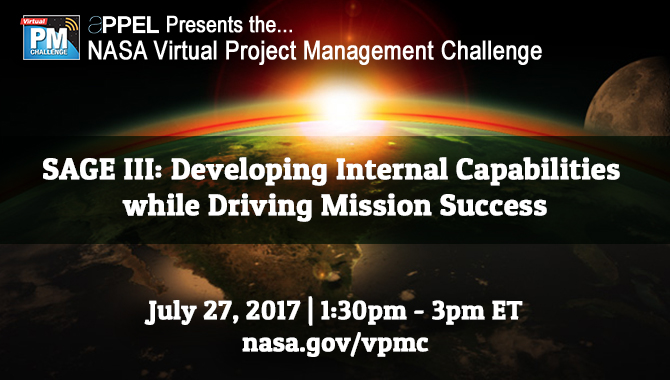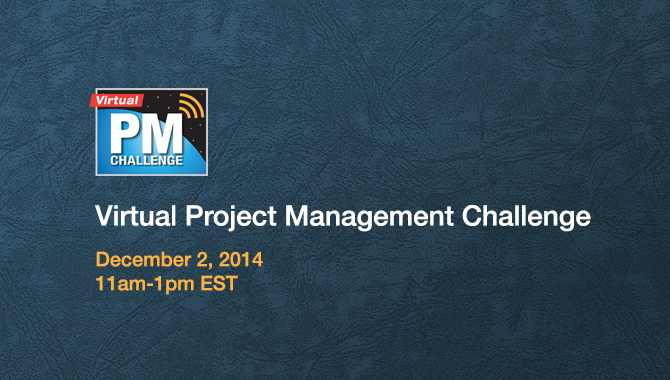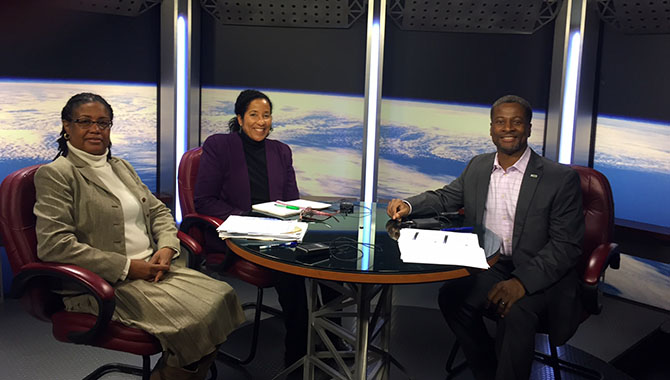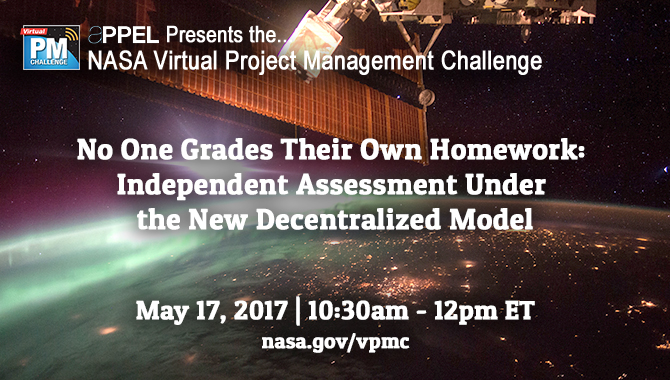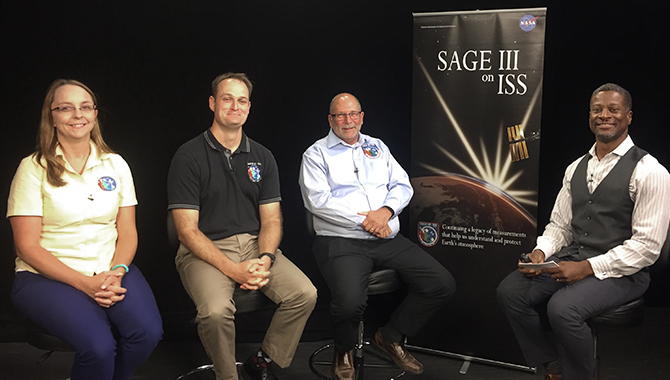
SAGE III/ISS Chief Engineer Kaitlin Liles, SAGE III/ISS PM Joe Gasbarre, and former SAGE III/ISS PM Mike Cisewski joined Virtual PM Challenge moderator Ramien Pierre to discuss the ways in which in-house projects benefit the NASA workforce.
Credit: APPEL/Daniel Connell
During a recent Virtual Project Management (PM) Challenge, project manager Michael Cisewski offered sage advice on the unique benefits of in-house projects at NASA.
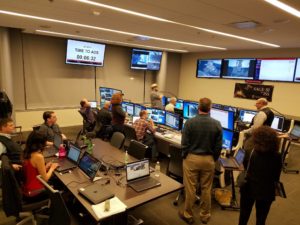
The SAGE III mission operations team monitored the installation on the ISS from the Flight Mission Support Center at NASA’s Langley Research Center in Hampton, Virginia.
Photo Credit: NASA/Kristyn Damadeo
In-house projects help the agency expand internal capabilities while advancing mission success. This was highlighted in the 2007 report, Building a Better NASA Workforce: Meeting the Workforce Needs for the National Vision for Space Exploration, in which a subcommittee of the National Research Council’s Space Studies Board addressed something long known within NASA: in-house space flight projects provide NASA engineers with the hands-on experience they need to develop critical expertise in project management and systems engineering.
The value of in-house projects was the subject of the Virtual PM Challenge SAGE III: Developing Internal Capabilities while Driving Mission Success. During the event, Cisewski, Project Manager for the Stratospheric Aerosol and Gas Experiment (SAGE) III/International Space Station (ISS) from 2009-2017, talked about the benefits of managing the project within Langley Research Center (LaRC) as well as how the SAGE III team successfully developed and launched their project despite a 15-year hiatus in large in-house space flight projects at LaRC. The Virtual PM Challenge is now available to view online. APPEL News caught up with Cisewski after the Challenge to find out more about how in-house projects benefit the NASA workforce and the organization overall.
APPEL News: During the Virtual PM Challenge, you discussed the important role that in-house projects play at the agency in developing and maintaining a skilled workforce. If the audience could take away only one thing from your presentation, what would you want that to be?
Mike Cisewski: The most important thing for people to understand is that engineers need difficult and meaningful work in order to develop and sharpen their skills. They need to get in there and struggle with the details, figure out how to make things work. The best way to get that kind of work is through in-house projects, where we design, fabricate, test, and fully develop everything instead of contracting out the work. In-house projects force folks to get their hands dirty and develop the skills our work demands. This maintains the overall health and technical chops of the agency.
APPEL News: Does that need to do difficult and meaningful work apply to everyone in the NASA workforce or just early-career employees?
Cisewski: Everyone. I believe engineers learn by doing. For experienced people, working on hands-on projects keeps our skills sharp. For the fresh out, the new generation of workers, it enables them to develop their abilities. Having a continuous stream of projects to challenge and develop the workforce is, in my mind, effectively a strategic imperative. It serves the agency for future in-house projects, plus it makes us smart buyers when to comes to working with contractors.
APPEL News: In the Virtual PM Challenge, you talked about striking a balance between experienced project members and newer engineers on your team. Do you have any advice for project managers who are looking to create that balance on their own teams?
Cisewski: The biggest thing is that when you plan your workforce for a project, you have to start by thinking about that mix and where you might have slots for the young engineers. This is so important because if you don’t develop that next generation of talent, you’re missing a huge opportunity. At NASA, the age distribution of engineers is on the gray side. I think the statistics are that roughly 50% of the workforce can retire in the next 10 years. We have the potential for a huge brain drain. If all of those gray beards retire and we haven’t run the next generation of engineers through a development cycle and things like that, how are they going to be able to execute? We have to go ahead and make sure we bring up the younger generation, get them the experience they need so we’re not running the engine dry in five years.
APPEL News: When you staff up for a project, do you think of it as investing in the future of NASA?
Cisewski: I do. If you think of the objectives of in-house work, one is you have to meet the mission needs. For instance, SAGE III is a continuation of things that we’ve done at Langley for a long time to monitor the health of the ozone layer. We do it really well. When we developed SAGE III, we knew we needed to meet the commitments of getting the correct ozone measurements today. But we also had to leverage the team to make sure we have the workforce and the skills available so we can get the right measurements tomorrow, too.
How you make those decisions about how to staff up is hard. The way we’re organized at Langley is in a matrix. We work with different branches and technical disciplines. Each branch or organization is a little bit different as far as their workforce development needs. So the way you work with the organizations and the branches is really important—and also strategic—to make sure that you create opportunity for development where it’s needed.
Like I said during the Virtual PM Challenge, when I was thinking about staffing SAGE III, I looked at the young folks as good draft picks. And I’m proud of the people we brought up. Their experience will help NASA and Langley over the next 10 to 20 years. Because they were part of SAGE III, they know how to work a project and do it well.
APPEL News: It’s clear you want to help develop the next generation of engineers at NASA. Did you get that kind of help when you were starting out?
Cisewski: When I first came on, I started on an in-house project, so I learned by doing. Since then, I’ve worked on other in-house projects and on prime contractor projects. I’ve worked on a good mix. The key thing about the difference on an in-house, as I’ve said, is you’re actually getting your hands dirty. On a prime contractor-based project, you’re trying to work with the contractor, but you have less of a direct role. You need to know your stuff but you don’t have to do everything yourself.
APPEL News: During the Virtual PM Challenge, you talked about how you used a lot of sports metaphors and other sayings with your SAGE III team. Did you find any of those phrases particularly effective or helpful in getting things done?
Cisewski: I had a lot of them! The team created a bingo card for me with all the catch phrases I used during the project. This is a good one: We’ve met the enemy and it is us. And another I said a lot: Slow down to speed up.
APPEL News: “We’ve met the enemy and it is us.” Can you tell us more about that?
Cisewski: One of the things about the in-house projects that’s maybe a little bit unique is that the enemy is us. When there’s a problem, we’re the problem. If you’re working on a contract job, sometimes it seems like your prime contractor’s having the problems while your team is perfect. But if the project is in-house, you’re the ones that have to execute. So if there’s a problem, you need to look in the mirror. That’s a lot of it. The other thing is that if you want to lead a team, the most important thing I think you can do is make sure that you have good team chemistry.
APPEL News: Do you have any tips for creating good chemistry in a project team?
Cisewski: We had something we called Burgers Out Back, where the team got together outside of the job. What we found was you could go ahead and talk about problems informally when people are having a hamburger or something and it creates a different vibe than if you’re talking about it in a high-pressure meeting. That worked well.
APPEL News: Thanks for taking the time to talk with us further about the value of in-house projects at the agency. Before you go, is there anything you’d like to add?
Cisewski: I’m really grateful for the SAGE III team’s efforts and I’m proud of what they accomplished. We were working six or seven days a week, two shifts a day, on a pretty aggressive schedule. But when we had a problem, nobody complained. They just went ahead and dusted themselves off and then we figured out how to solve the problem and move on. At the end of day, it’s extremely rewarding and fulfilling to watch wonderful people bring their A games to help you succeed. It’s just incredible.
The Virtual PM Challenge SAGE III: Developing Internal Capabilities while Driving Mission Success can be viewed online.
To receive email notifications about upcoming NASA Virtual PM Challenge sessions and recorded session availability, please subscribe to the Virtual PM Challenge email list.
______
Michael S. Cisewski currently serves as the Project Manager for the Radiation Budget Instrument project at LaRC. Previously, he managed the SAGE III/ISS project, which launched successfully in 2017. Cisewski also held management, operations leadership, and technical positions in the Clouds and Earth’s Radiant Energy System Flight Model 5 and Flight Model 6 project, the NASA – Centre National d’Etudes Spatiales (CNES) Cloud-Aerosol Lidar and Infrared Pathfinder Satellite Observation (CALIPSO) project, the NASA – Roscosmos Meteor 3M/SAGE III mission, and the Thermosphere, Ionosphere, Mesosphere, Energetics and Dynamics (TIMED) satellite mission with the Sounding of the Atmosphere using Broadband Emission Radiometry (SABER) instrument development.
Cisewski started his career at NASA with the in-house Halogen Occultation Experiment project, which launched on the Upper Atmosphere Research satellite in 1991. He is the recipient of the NASA Outstanding leadership medal and was twice awarded the NASA Public Service medal for his support of the NASA mission.






